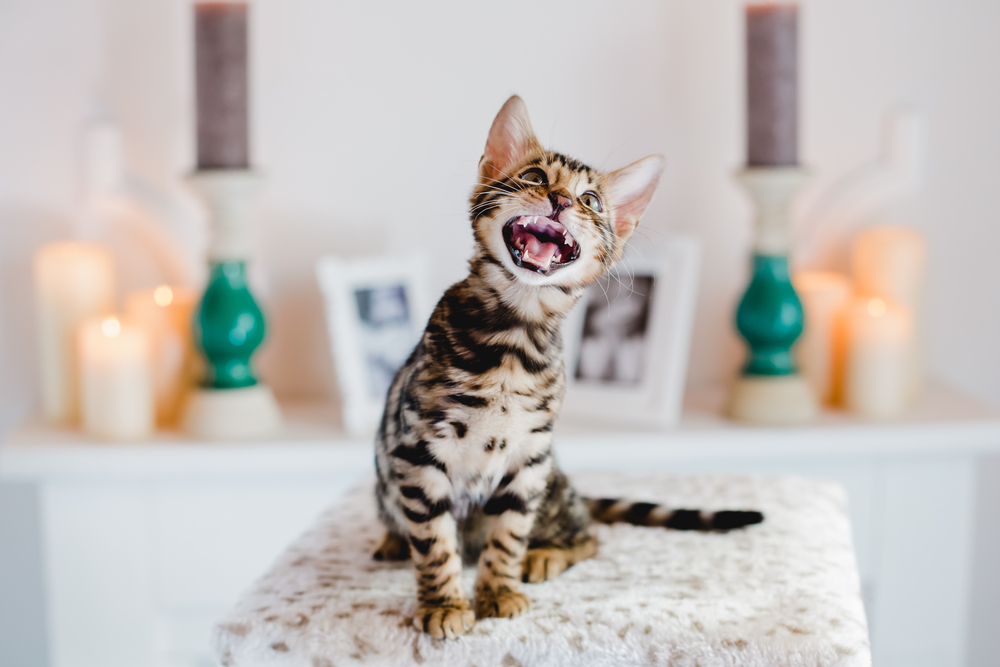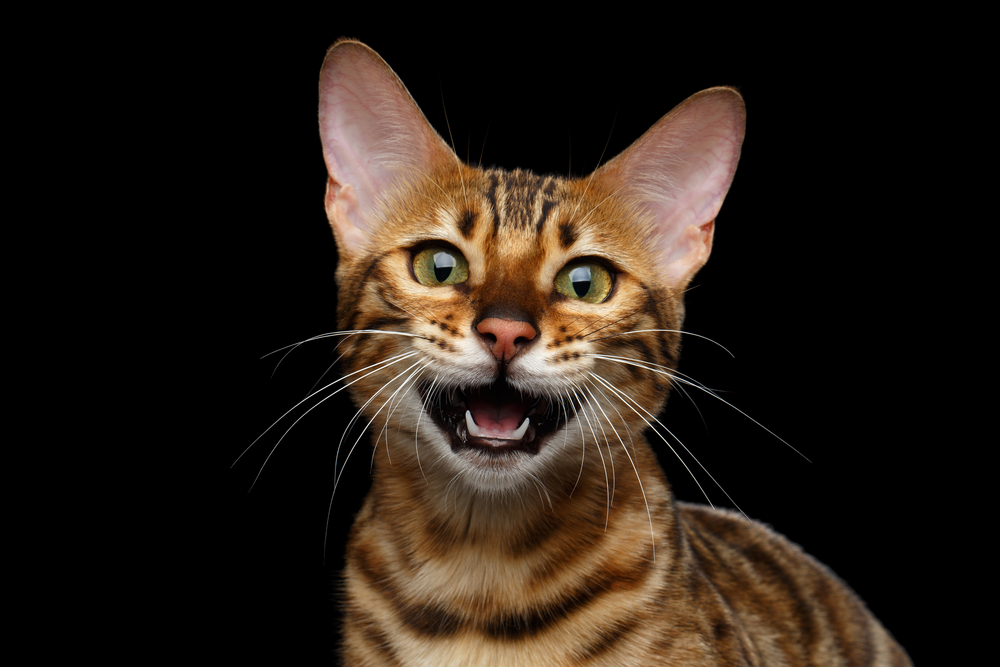Do you think that the sounds your cat makes – the meows, chirps, yowls, purrs, and other cat blabbers – are random gibberish? You might want to think again. Your cat might be trying to communicate with you and you don’t even know that. What are the most common Bengal cat sounds, anyway?
When you bring a Bengal cat home, you’re probably going to notice that these Lilliputian leopards are always on the move. Bengal cats are the closest you can get to owning a wild cat without breaking the law considering that they’re a cross between the Asian leopard cat and the Egyptian Mau.
Bengal cats are wild-looking creatures with lean, athletic builds and rosette-patterned coats, and they’re a sight for sore eyes, that’s for sure. What makes them different from other cats, however, seems to be the fact that they’re quite the Chatty Cathys and that they aren’t above speaking up and telling you off.
Whether they’re meowing at you because they’re hungry, chirping because they’re proposing a cuddle session, or growling because they’re annoyed by the fact that they aren’t allowed to go outside, Bengal cats are known to produce quite a significant number of strange sounds.
Why do Bengal cats make strange sounds? What are the most common Bengal cat sounds? While not all cat breeds are chatty, knowing about cat sounds allows pet parents to better understand the cat’s needs, moods, and messages. We’re bringing you everything you need to know and more down below!
Why do Bengal cats make strange sounds?

All cats make sounds – from meowing and purring to growling and caterwauling – but some cats are more vocal than others. Cats communicate with humans by meowing at them, for example, but they’re more likely to resort to body language and body odors when they’re communicating with other cats.
What’s the tea on Bengal cats, though? Why do Bengal cats make strange sounds? Whether they’re meowing as a form of greeting or emitting strange sounds to express happiness, appreciation, fear, pain, and aggression, Bengal cats are communicative creatures and you need to figure out what they’re saying.
When we’re discussing the whys of Bengal cat sounds, we’re almost always talking about genetic factors, environmental influences, and a way of communicating with humans. For example, Bengal cats are known to produce sounds you’ve never heard before because they’re descendants of wild cats.
Asian leopard cats happen to be a species known for wild vocalizations and great vocal abilities. Bengal cats might have inherited the same specific vocal traits from their wild ancestors and continued using them to communicate. Furthermore, the environment they’re in can be the thing to blame, too.
When Bengal cats grow up surrounded by strange sounds, animals that communicate with each other by making different noises, or simply an apartment (and a family) that’s quite noisy, they’re known to develop more vocal habits. Finally, that’s how Bengal cats communicate with humans.
Bengal cats are incredibly intelligent and intuitive, and they’re known to have a strong desire to communicate with humans. Because they don’t speak English (or whatever your mother tongue might be), they’re forced to produce strange sounds to get your attention or demand affection.
10 common Bengal cat sounds
1. Meowing

Meowing might be one of the most common Bengal cat sounds, and that’s great – because all cats meow. What you might not know about meowing, though, is that the meow is almost exclusively used to communicate with humans. Grown cats aren’t likely to communicate with other grown cats by meowing.
What do Bengal cat meows mean, though? When your little Bengal beast starts meowing at you, she’s probably greeting you, trying to play with you, expressing excitement or frustration, or simply asking for attention and affection. Meows can sometimes indicate boredom, stress, frustration, or illness, too.
2. Chirping
All cats meow, but do all cats chirp? A chirp refers to a short, high-pitched call that sounds similar to a bird and it’s common among mother cats contacting their kittens. Meowing and chirping are similar in the way that both are used by mother cats calling on their kittens or grown cats calling on their humans.
When aimed at humans, chirping serves the purpose of letting you know where your cat is, calling on you for help, or even expressing your cat’s excitement about seeing you (when she wasn’t expecting to see you, for example). Cats sometimes chirp when they see a bird or a mouse through the window, too.
3. Purring
We’re all obsessed with our four-legged friend’s purrs, but what does the rhythmic sound represent? Cats start purring from a young age, typically when they’re nursing or feeding. When they grow up, they associate purring with comfort, safety, and security.
So, once you notice your Bengal cat purring, know that she’s comfortable around you. When cats purr to demand food, though, you might hear them make other sounds, too. Purring can also indicate that your cat is uncomfortable or unhappy, but you will see her change her body language completely, too.
4. Growling

Growling refers to a low rumbling sound you might hear when your little leopard starts causing trouble around the neighborhood. When cats growl, they’re typically trying to warn or scare off a threat – whether that threat actually exists or not. What do we mean by that?
Cats are sometimes known to growl at vacuum cleaners, blow dryers, or pretty much anything they’re unfamiliar with. When you have your friends over, your cat might start growling at them. When you’re teasing your cat, she might start growling at you, too. Growling almost always indicates a warning.
5. Screaming
We don’t want to be anywhere near you when your cat starts screaming, that’s for sure. A cat screaming sounds a lot like a human screaming, except a bit more urgent and desperate. When you hear your cat scream, you might think that she’s fighting with other cats or screaming out of pain, but that’s not it.
Screaming typically indicates that something is wrong. Whether your cat got scared of something, started experiencing some sort of pain or discomfort, or started mating with another cat, you might hear her scream. When your cat starts screaming and you can’t figure out the reason, contact your vet.
6. Hissing
Screaming might scare you away, but hissing indicates that your Bengal cat means business. A hiss refers to a low, drawn-out sound that can be soft or loud, depending on the situation. A hissing cat might have her mouth open and teeth exposed, too. When a Bengal cat starts hissing, she’s probably expressing her aggression.
Bengal cats have quite a reputation for being aggressive. While we can’t say for sure that their wild origins have anything to do with them being aggressive, we can say that not all Bengal cats are that way – they’re mostly affectionate, appreciative, and fun to be around.
A hissing Bengal cat might not be your BFF, though.
7. Trilling

Moving on to more pleasant Bengal cat sounds, a trill refers to a sound produced with a soft voice that resembles a white noise machine. A cross between a meow and a purr, a trill is typically used as a form of acknowledgment or greeting and is a way for your cat to tell you that she’s happy.
Cats might trill to thank their human family members for something, such as a snack or a pet. When your cat trills at you, know that she’s satisfied with you and that she’s trying to tell you how much she appreciates you. Cats might be reserved and standoffish at times, but not when they’re trilling.
8. Yowling
We mentioned beforehand that cats produce a myriad of strange sounds when they’re trying to communicate with humans. Bengal cats are more prone to long, loud, drawn-out sounds made with an open mouth because they’re wild. Or at least that’s what we believe to be the case.
Yowling refers to a howling sound that’s a little longer and louder than anything you’ve ever heard before. When your Bengal cat starts yowling, know that she’s afraid, unhappy, uncomfortable, and possibly in distress. Whether she’s fighting another cat or experiencing pain, she’s not yowling because she’s happy.
9. Chattering
We’ve all seen adorable TikToks of cats making clicking sounds with their mouths. We don’t know why, but we’re obsessed when cats produce sounds we’ve never heard before. Worry not, Bengal cats are known to produce chattering or twittering sounds, too.
When they’re looking outside the window, observing their potential prey, or sneaking around the apartment, they’re likely to start producing these clicking sounds. Chattering occurs when a cat starts smacking her “lips” together or clashing her teeth together – it sounds much more uncomfortable than it is, though.
10. Caterwauling

We’ve arrived at the end of the article with another “uncomfortable” sound.
Caterwauling refers to a loud, long whining sound made by unspayed female cats wanting to attract prospective mates while they’re in heat. Male cats aren’t likely to caterwaul, but we’ve seen instances in which cats caterwaul because they’re mimicking each other’s sounds, too.
When your cat caterwauls at you, though, she’s probably trying to tell you that she’s in pain or that she’s desperate for your attention. Different sounds have different meanings, but we do urge you to observe your cat’s body language when you’re trying to determine what she’s communicating.
